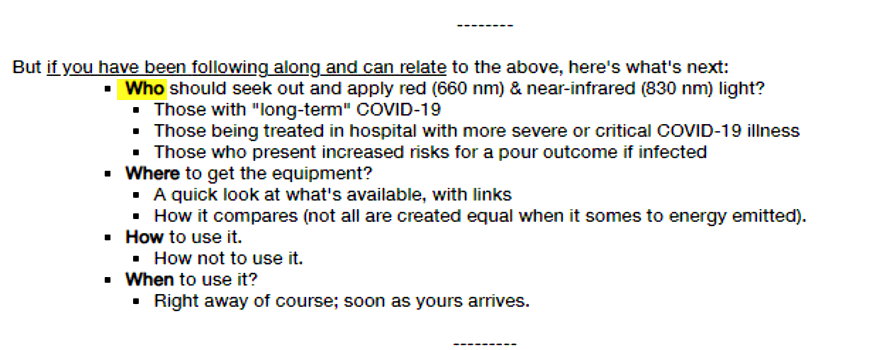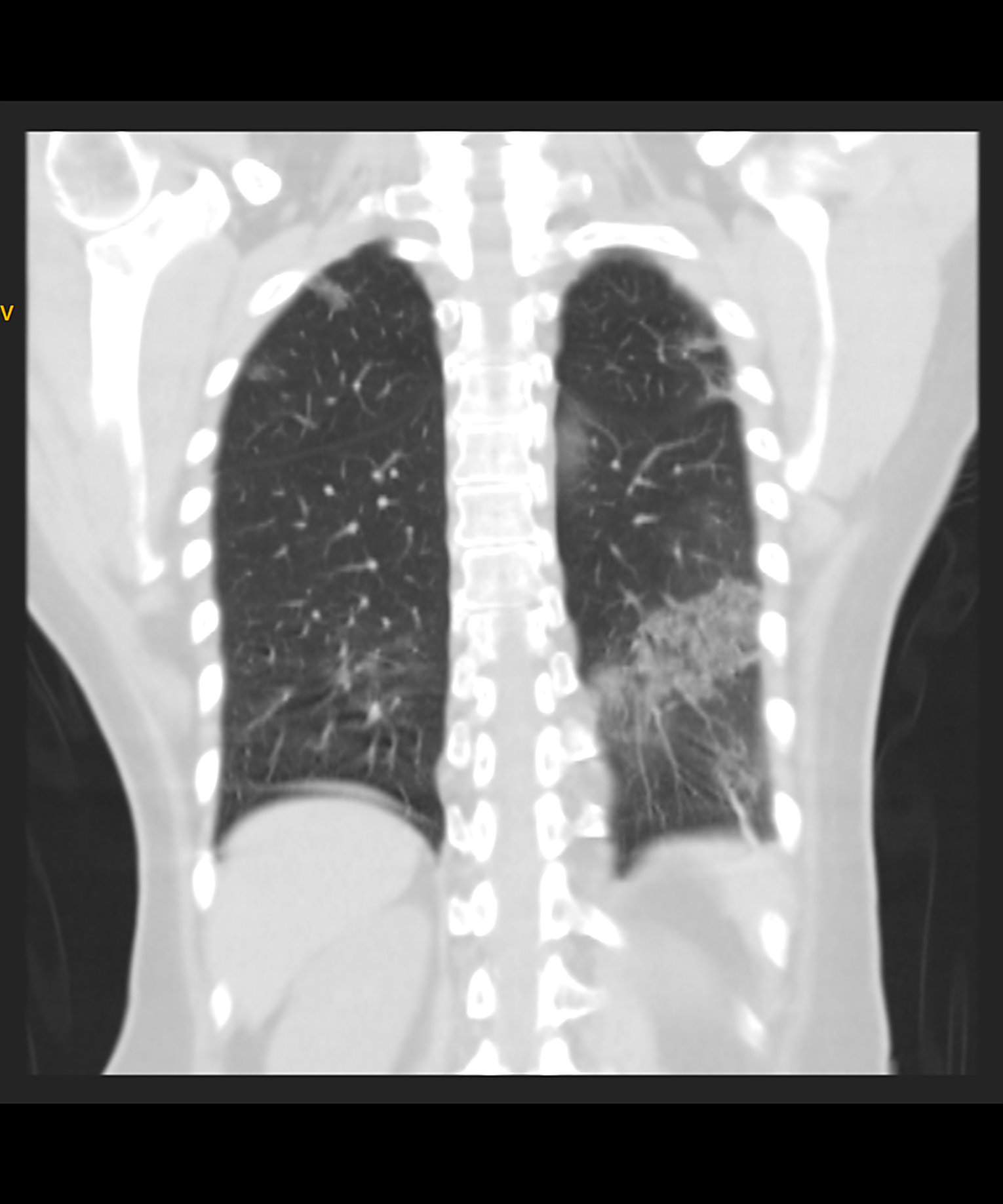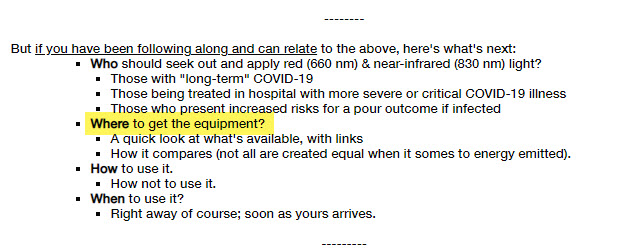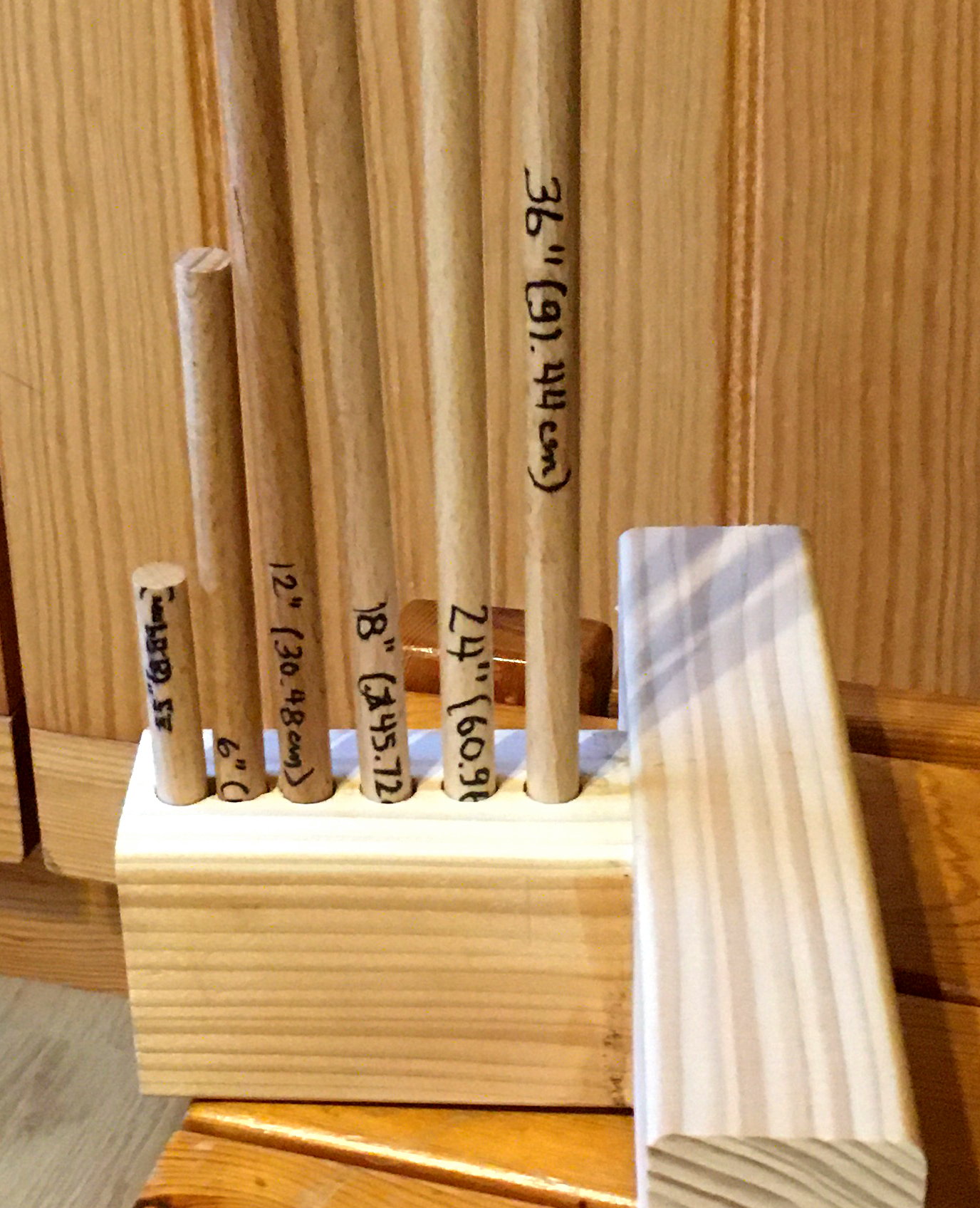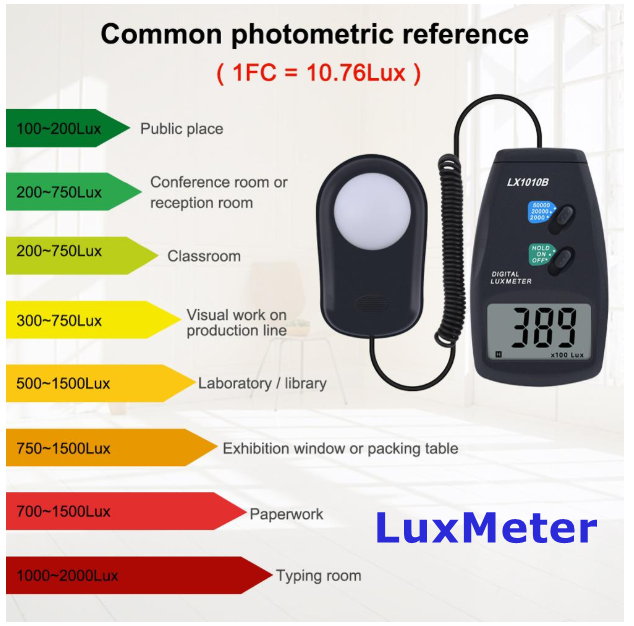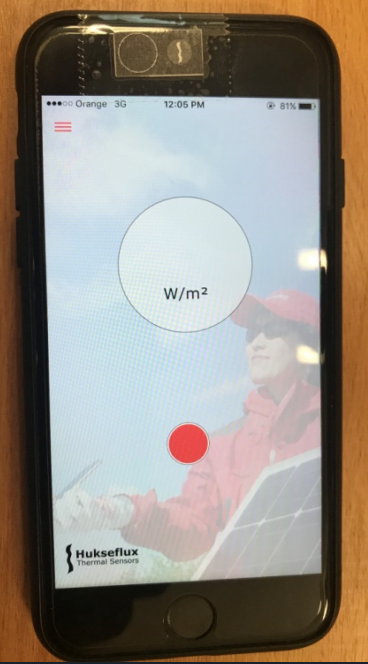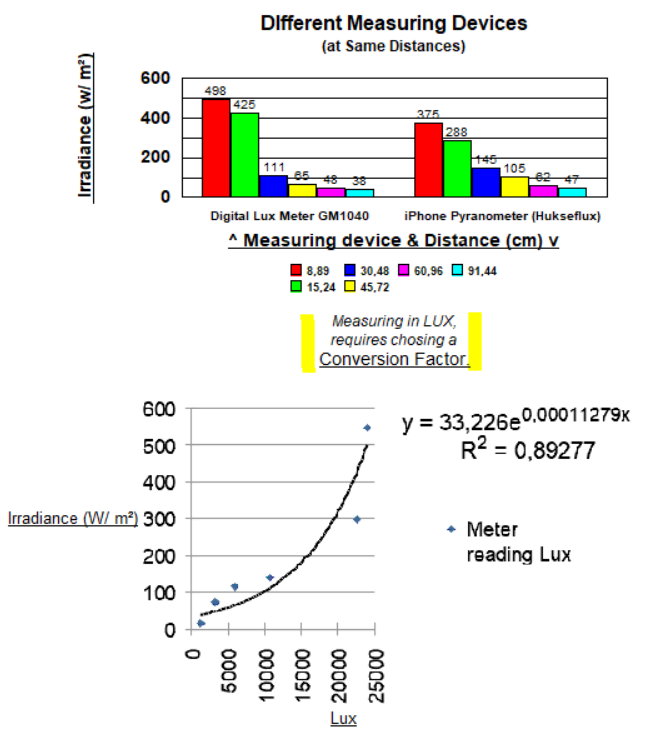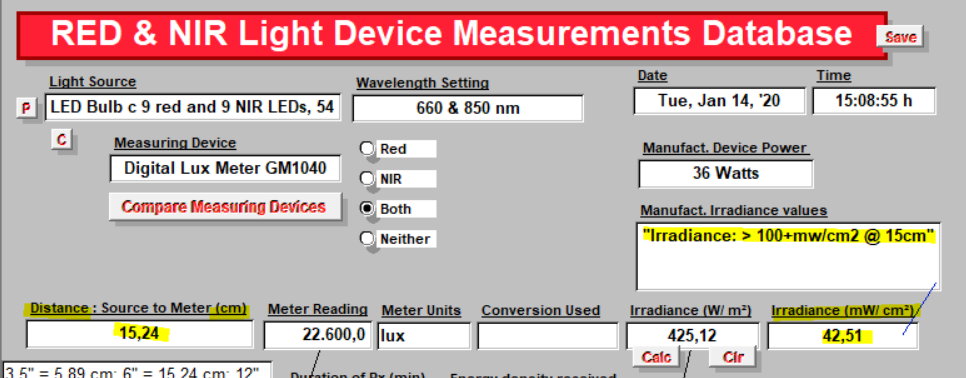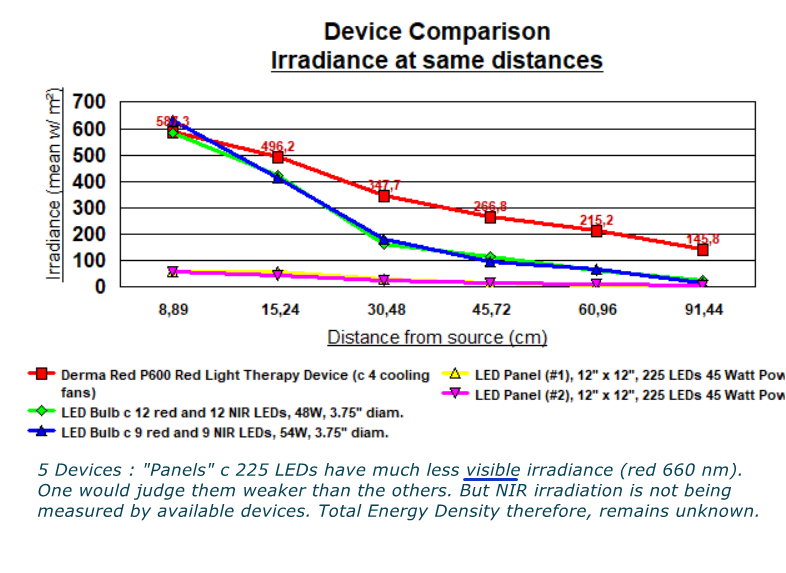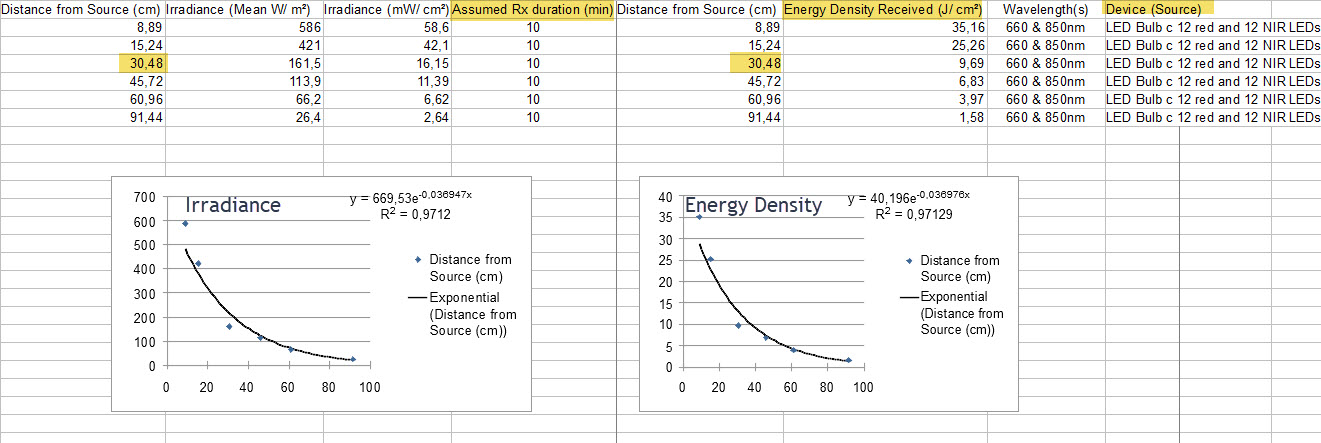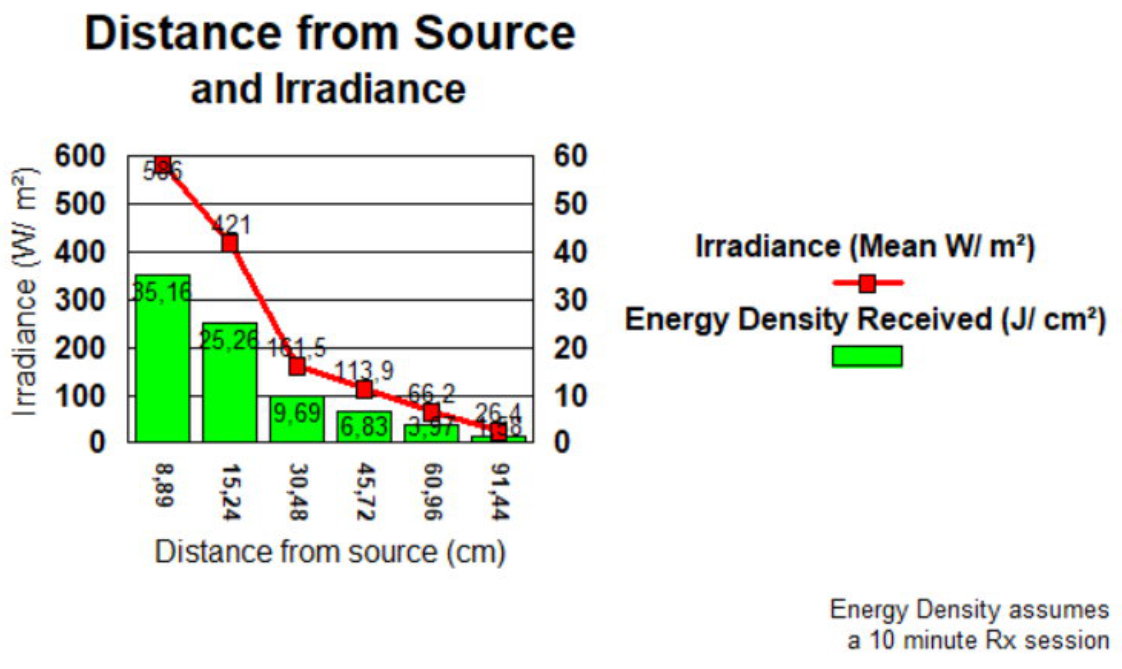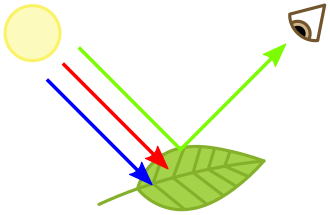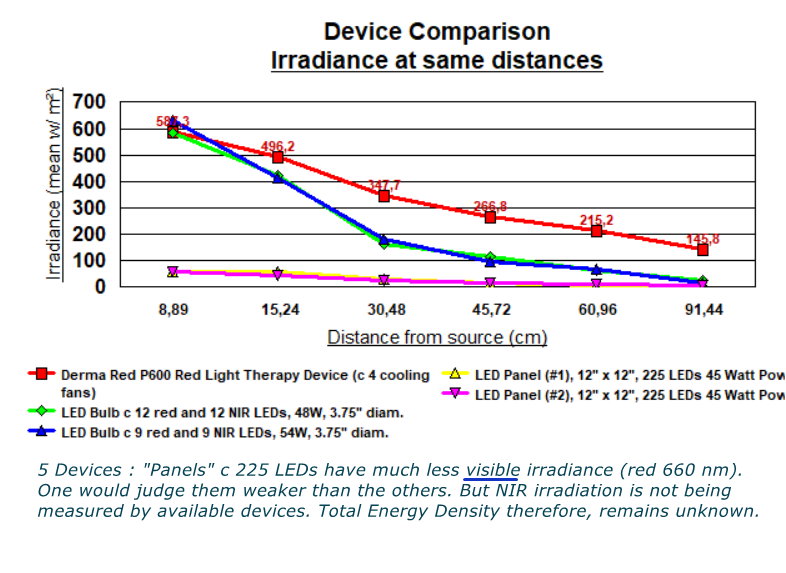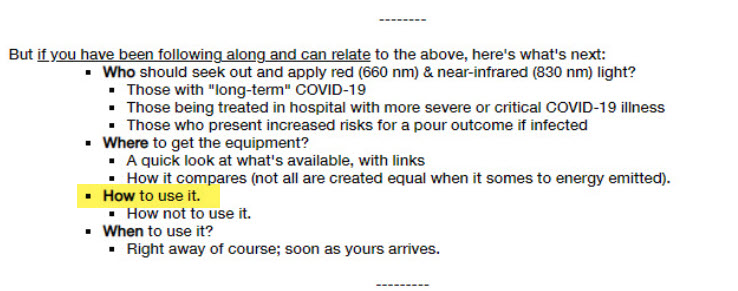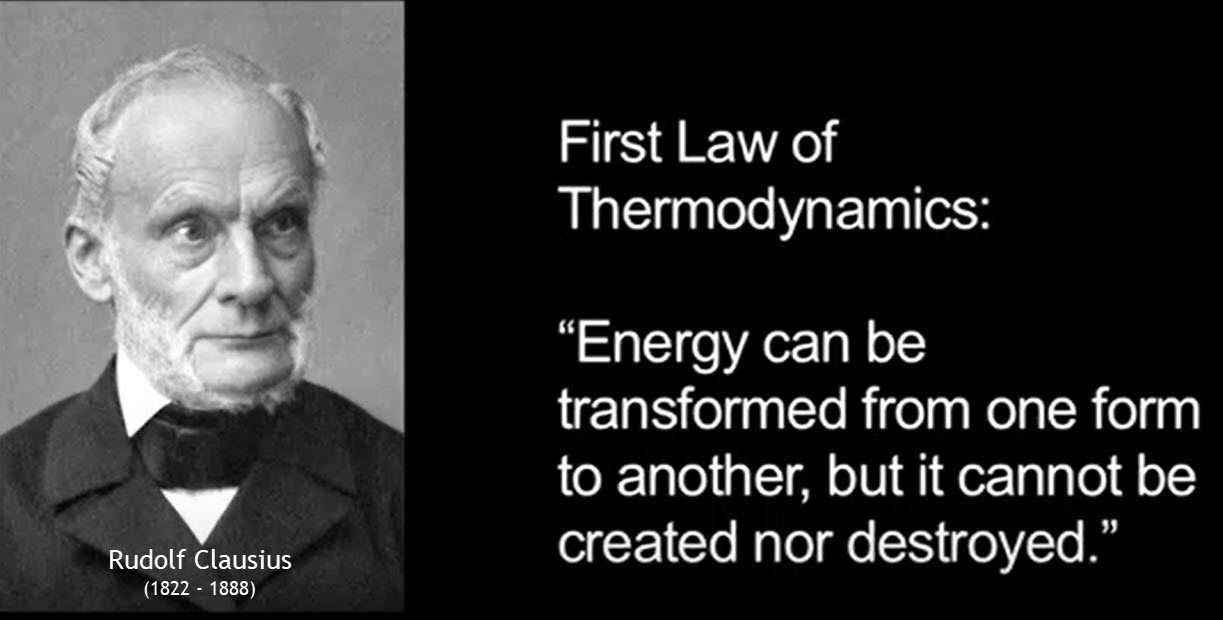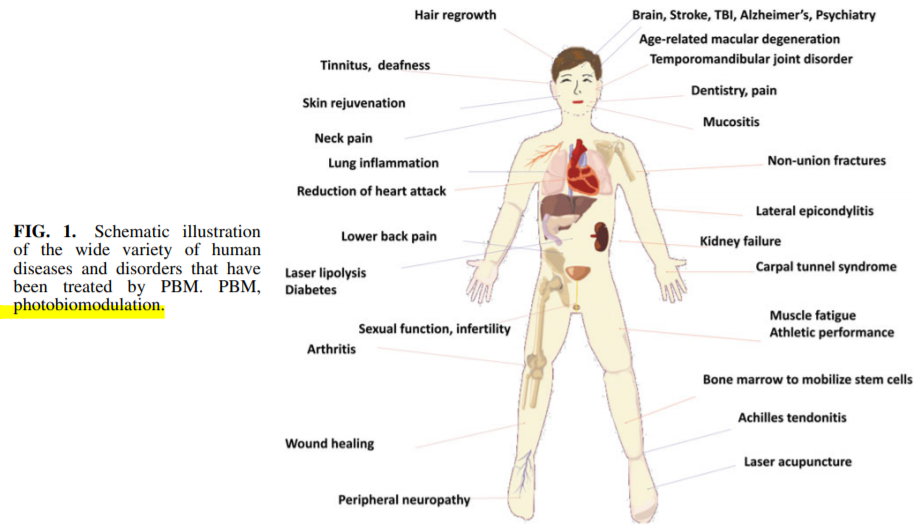Putting It Into Practice
Putting It All Into Practice
LTCOVID.com
Thanks for visiting!
To translate this page, select your
language from the dropdown menu below:
Lay down your concerns over what others might think, and forge ahead.
- A Questionnaire has taught us so much about an illness : "long-term" COVID-19.
- We have learned a great deal about this illness from those who responded. Our teachers.
- We have a hypothesis based on #1 & #2; that this is an energetics problem. That hypothesis includes:
- That mitochondria are in need of repair to beat the problem.
- That other critical substrates like phosphorus, are essential, but only effective after the repair process is well underway.
- Science is on our side:
- we understand mirochondria now, and so much of what they do. Far from everything.
- we know mitochondria can become ill, and have become ill during "long-term" COVID-19
- we know that red (660 nm) and near-infrared (830 nm) light is:
- safe, if properly applied
- been used to heal problems in many other types of illnesses
- fits the needs of the "long-term" COVID-19 illness to reverse extant problems of energetics
- readily available
- very amenable to Do-It-Yourself therapy at Home (you don't need a CAT scanner or OR table).
- Unlike lasers that generate heat along with their light, the LED variety of this LLLT generates very little to almost no heat. Let go of the idea of applying this light to warm up tired, sore muscles. It may help those muscles, but not by heating them up like infrared. While tanning beds and UV light have always had more attention, and an overlay of causing skin cancar, red and near-infrared light:
- also comes from the sun - red is visible; near-infrared not, though close, but both still sunlight
- excess tanning at the beach has painful side effects, typically not true for red and near-infrared, yet excess may be possible. Unlike infrared light that treats by heating, as just mentioned, these don't.
- I don't have a single reference in my possession that suggest being a cause of cancer.
- Light from the sun is free. Something very nice about that. A gift.
-
And like the sun, we must find all possible ways to simply give it away to all those who need it. And they are many.
- You can buy and own your light. You can never own its light.
If All This Means Nothing To You: You're Probably Lost.
Click the link at the top of this page that reads: "LOST: SHOW THE MAP" and start over.
--------
But if you have been following along and can relate to the above, here's what's next:
-
-
-
- Who should seek out and apply red (660 nm) & near-infrared (830 nm) light?
- Those with "long-term" COVID-19
- Those being treated in hospital with more severe or critical COVID-19 illness
- Those who present increased risks for a pour outcome if infected
- Where to get the equipment?
- A quick look at what's available, with links
- How it compares (not all are created equal when it somes to energy emitted).
- How to use it.
- How not to use it.
- When to use it?
- Right away of course; soon as yours arrives.
- Who should seek out and apply red (660 nm) & near-infrared (830 nm) light?
-
-
---------
In all of the above, I have no stakes in this. Meaning, I have no motivation to be recommending a
manufacturer, seller, reseller, or anyone in the finances related to such purposes and applications.
No contract with anyone. No percentages of sales. Nothing like that. Free as a bird.
I'll share information about what I obtained, and from whom. After that, ... up to you.
Not completely a coincidence, I began studying red & near-infrared lights well before anyone had the words pandemic or SARS-CoV-2 on their lips. Started a few years back. As the references already presented adequately confirm, many have been deep into study of methods, materiel and indications for use of photobiomodulation (PBM) for years. As shown the results are there. Is there still uncertainty and a lack of knowledge about all aspects of low level light therapy (LLLT) and how/ why it works? Absolutely.
Then of course, there is still much to be learned about how a human brain works.
That doesn't keep neurosurgeons from operating on them every day.
I bought several such lights, appliances furnishing light through LEDs, and studied them.
Various sizes, various conformations, various prices.
I'll share what I learned, but this last section of our LTCOVID.com site, will aim at moving right ahead
towards reducing, if not ending, the suffering associated with "long-term" COVID-19.
This is no longer, as we learned to say during Surgical Residency: "If you can't fix it, don't find it."
I think this can be fixed.
Because of the mysteries, apparent inconsistencies, and unusual aspects of the "long-term" COVID-19 illness, we are currently still living a ‘wait and see’ approach.
Those with it, are waiting to see if it will just go away or present with another recurrence, as some have unfortunately lived. And yes, specific clinics have opened for their treatment. A multi-disciplinary approach is being structured. That's good. Let's get 'em the light.
If I had an attorney she would probably advise me not to start talking diagnoses or making promises about therapeutic interventions, nor forgetting to mention all possible complications. She would say I should make it clear that I'm not responsible for anything bad that happens. If I forgot to tell everyone not to use this electric device while taking a bath, a shower, or swimming in their pool, and someone did, and suffered an undersired outcome, well I'd be sad for that person.
But after about 40 years of doing everything I possibly could do to make a sick patient better, I think I'll just keep listening to my instincts. You should try the light, see what you think, and listen to your instincts as well.
Then give it away.
<<<< Previous page
Who needs this ? >>>>>
<<<< Home
Into Practice: 1. Who?
LTCOVID.com
Thanks for visiting!
To translate this page, select your
language from the dropdown menu below:
Realization
Lost? Then click on the 'LOST: SHOW THE MAP' link in the above menu.
WHO ?
1.
- If you responded to our "long-term" COVID-19 questionnaire, its combined response data and question by question analysis, suggests that you should try without hesitation, low level light therapy (LLLT) with a red (660 nm) and near-infrared (810 to 830 nm) device. (The Where, How, and When will follow on separate linked pages).
- Here are two recent articles (1) and (2) that address the differences in presentation of the COVID-19 illness, including those self-termed as "long haulers." The articles conclude rather cautiously that the reasons behind these variations in presentation are not known. What if it was the energetics issue as our questionnaire clearly suggested? What if LLLT could improve the myriad symptoms or even bring them to an end, without leaving the security of one's home?
2.
- If you are a patient in the hospital who is severely ill and trying to avoid progression to a critical illness, with possible need for intubation, mechanical ventilation and additional support to maintain oxygenation, those caring for you should strongly consider our protocol. If you are not the patient, but know such a patient, keep reading.
-
- Developed months ago, (April 4, 2020) it is still as valid as ever. It presents LLLT in a certain context. If those providing care learn from it, but decide to change it to fit their needs, so much the better. But they must strike while the iron is hot.
- If you or someone you know has a CT Scan of the chest that looks like this image below, this protocol should be considered and tried.
- As we saw in previous articles, it appears that the use of such therapy is finally catching up in the world to our protocol from last April.
Here is our protocol: Protocol for photobiomodulation of COVID-19 pneumonia - April 4, 2020.
Here is our protocol in French: Protocole de photobiomodulation pour pneumonie dû au COVID-19.
For any and all questions related to these protocols, contact information is provided in each.
So share these protocols broadly, without hesitation. And if you'd remember to mention LTCOVID.com, that would be nice as well.
3.
The responses to our questionnaire and their analysis leads to a hypothesis of problems in mitochondrial energetics as the fundamental problem of "long-term" COVID-19.
These responses were also able to confirm, through several comparisons, what is already suggested in the literature. Certain individuals are more at risk for a less than optimal outcome. You are probably already aware of these groups who may find themselves more often among those with less desireable outcomes from COVID-19. Individuals who are older, overweight, smokers, diabetics, those having who multiple symptoms each day even before COVID-19, those in the BAME (Black, Asian, Minority Ethnic) populations. They appear quite evidently as respondents to our questionnaire.
If we are correct that this illness presents an energetics problem, that the SARS-CoV-2 virus hijacks and damages sources of cellular energy throughout the body, this clearly poses a greater threat for all those listed above. They are starting their fight against the virus, from a position of depleted energy.
Of course, the best solution is to never catch the virus at all. And at the same time, work to correct all the deficits in the above list, that can be corrected.
Part of that "correction" would be to top off cellular energy stores. Much like topping off gasoline in one's car before heading out on a long trip. Doing so, doing both, prevents undesired outcomes (more severe illness, or running out of gas in the middle of nowhere!).
So there should be no hesitation for those in Group 3 to use LLLT with red (660 nm) and near-infrared (810 to 830 nm) light to fill up their cellular energy tanks. Just in case of viral attack, and consistent with a drive towards "wellness," even if the virus never strikes. You should feel the difference in short order.
<<<< Putting It All Into Practice (Prev. Page)
2. Where shall we find these lights? >>>>
<<<< Index of Articles
<<<< Home
Into Practice: 2. Where?
LTCOVID.com
Thanks for visiting!
To translate this page, select your
language from the dropdown menu below:
Realization
Lost? Then click on the 'LOST: SHOW THE MAP' link in the above menu.
WHERE ?
As I indicated before, and I quote ...
"In all of the above, I have no stakes in this. Meaning, I have no motivation to be recommending a
manufacturer, seller, reseller, or anyone in the finances related to such purposes and applications.
No contract with anyone. No percentages of sales. Nothing like that. Free as a bird.
I'll share information about what I obtained, and from whom. After that, ... up to you."
What I purchased, starting over a year ago now, was motivated by being intrigued with red and near-infrared light, and a desire to study it. That study included measurements and comparisons of several products. I discovered that these differed in several categories:
-
-
-
-
- physical size and dimensions
- power or irradiance
- price
- availability
- differences in degree of sales hype, seriousness, who they were pitching to
- adequate and accurate explanation of what a product is and does.
-
-
-
Below, we'll present some examples of these, with links to the source where they were purchased.
Given the previous article on WHO should obtain and use such a device, I think saving up a few years while considering and reconsidering making a purchase, doesn't fit with the present set of circumstances. I guess I'm already leaning towards a recommendation of getting something affordable but still effective. Effective means more towards regenerating tired out mitochondria, and less towards reducing facial wrinkles, for example.
I will present little galleries below. They allow several images to pass before your eyes.
These aim to give you an idea, or several ideas if all this still means very little.
Science (watch out)
First, just a few results of my study which involved measuring light at several fixed distances from the source of light. First, measured with what? With two different instruments, which measured visible (red) light. These lux meters permit converting their measurements into values for irradiance in Watts per meter square (W/ m²). As anticipated and learned, two different measuring tools will give somewhat different results, but may capture correctly, general trends. One important trend, a principle of the opitics part of physics, is that given a point source, the irradiance diminishes with distance.
So to make sure distances were always the same for each measurement, we made a set of distance sticks. You'll see some of these numbers or lengths on graphs below.
An example of one of the tools we used to measure is this ...
Or if you like iPhone Apps, here's one ...
A pyranometer made by Hukseflux.
A pyranometer is a type of actinometer used to measure solar irradiance. I won't push that explanation.
So now you can get a light source, a meter, and repeat all my measurements and see if they agree or not.
We confirmed instrument measurement differences in our little experiment as seen below.
Then we threw all of the readings into a database, and voila, presto ..., data!
That allowed us to compare the manufacturer's advertised values with our measurements.
Here, manufacturer says "> 100+ mw/ cm² @ 15 cm" distance, and our measurement: 42.51 mW/ cm², at 15.24 cm. Distance between source and light meter: pretty close. Two irradiance values: pretty far.
Sometimes it's worth making measurements. Or, having the measurements someone else made for you.
Last little bit of science ...
-
-
- 5 different devices (we'll show you those)
- 6 different and specific distances from the source
- Measuring irradiance at the same distances from the source for each device
- Below we'll comment ...
-
We did not measure the amount of irradiance that these devices generae if pointed towards the moon, nor even 1 mile away.
That's a (perhaps) funny way of saying that the distance from the source to where irradiance is being measured, should have some relation to how these lights are going to be used.
And that distance might frequently be at 15 to 20 cm. (that's 6 to 8 inches).
Conclusion : so the above graphic teaches that
-
-
- the Derma Red P600 came in first for irradiance.
- That two different LED bulbs were a close second and almost identical.
- That two different LED sources with 225 LEDS, referred to above as "Panels" had much lower irradiance in the 660 nm wavelength light. So if this is a "how much bang for your buck?" comparison, these two particular panels came in equally, in last place.
-
Lastly, a very important bit of science
So far we've been talking light, but not energy.
We emphasized that we are trying to work together to solve an energy problem.
So where is the energy in all of this?
(click to enlarge, or it's pointless ...)
Notice the highlighted cells.
Notice that we here are measuring a device with 12 red and 12 near-infrared LED's.
-
-
- as distance from the source increases, a lower irradiance is measured (we knew that now)
- to begin talking energy, we need to know for how long the light will be on: here 10 minutes.
- so the irradiance for that amount of time, at the various distances, is the energy density
- energy density has units of Joules per square centimeter (J/ cm²)
- and here, we're now talking about transmitting (much needed) energy.
- at further away from the source than 30 cm (12 inches or 1 ft), energy density drops off pretty quickly as the fitted curve on these graphs shows.
- probably, in actual use, the sources won't be used to apply these energies at any greater distance.
- but one way to make a low energy treatment more effective, is to do it for longer.
- that's what "Energy density" is all about.
- through studies of a given topic, traumatic brain injury for example, will never fail to mention energy densities applied during their light treatments of patients.
- If you notice that a manufacturer or reseller is providing units of Energy density, take note.
-
If the different units from optics/ physics are starting to annoy, here's something that explains radiometric vs. photometric units of LEDs. Unless your about to take a physics exam in optics,
consider not even looking.
Let's Look Over What's Available
Here is a gallery of images for the Derma Red P600 Red Light Therapy device.
First thing to mention is that if it looks like some of the individual LED "lights" aren't working, those are the near-infared LEDs that one normally doesn't see, or barely. They're on. Want to confirm that?
Measure them.
To help get beyond the science and move towards your pocket book, here is a comparison
of two similar devices. Notice especially the different prices as a function of where you buy.
It also has the dimensions, weight, etc.
Here is one such seller, Care Lamps, that link presenting this product.
Here is another at Red Rush for the 720 ULTRA Body Light. A similar machine.
Having mentioned Red Rush, here is a summary of light therapy written for them.
Understandably it leads towards buying their products. But taken overall, it is a very complete introduction for the lay person, into what this is all about.
Last month was 1 year since my purchase of my Derma Red P600.
Quite an investment as cash outlays go for most of these items. Any regrets? None.
You saw its Irradiance and Energy density data above.
Telling you to buy one?
No. Telling you to keep on reading.
Just trying to seed some ideas here ...
-------
Next, a message from our sponsor, the sun.
Leaves appear to be green to us because they absorb (just like we do) the UV (blue) and Red light parts of the spectrum of sunlight. They reflect the green wavelengths which is what we see as a green leaf. When their chromphores (light loving parts) break down each Fall, they stop absorbing and we see their other colors.
This does not explain Little Green Men if you've been seeing any lately.
-------
Next. Here is a gallery of images for some combined wavelength (660 & 830 nm) LED bulbs.
These too come in somewhat different formats. Initially, these were Gro-Lights for plants.
Then someone got wise to the human factor. Boom! Sales went up.
In what follows, the topic switches from Science, to Marketing.
So prices have probably changed since when we wrote this in 2020.
In fact, the original links may no longer work since sellers and products come and go, and we are now in January of 2024.
Caveat emptor ! (Let the buyer beware !)
- Recall first, that these were in that mid-position of irradiance and energy density. So as long as one is under 30cm (12 inches) from the light source, quite acceptable.
- They too, when turned on, have several "lights" (LEDs) that seem to drop out. Those are the NIR LEDs (usually half of the total in any bulb). Not broken. Don't ask for a refund just yet.
- CareLamps sells a Derma Red Mini for 82.78€.
- Based on our DIY study, you can get the equivalent here:
-
- Bulb only for 23.43€
- Bulb, plus a clip-on holder with choice of EU, UK, AU or US plug for 30.57€
- Shipping to where I am: 3.85€
- I have purchased 3 of these.
-
Here is how they "pitch" these bulbs:
"Pain Relief 660nm 850nm
Switch on/off
660nm Red Light Therapy
E27 holder
red Therapy bulb lamp for Skin and Pain,
led grow light
LED therapy light Specification:
Input Voltage: AC85 - 265V
Color:black
Interface: E27
LED power: 18pcs X 3W
Actual power: 18W
Main application scope: whole body
Color Ratio: 660nm : 850nm = 1:1
Beam Angle: 60 degree
Plug: EU/US/UK/AU
Irradiance
@ 0 inch 144mw/cm2
@ 6 inch 120mw/cm2
@12inch 58mw/cm2
I have also bought 7 of these for 34.57€ each and free shipping.
Delivery times from these sources vary from 10 to 30 days, unless one moves out of the "free shipping" category for delivery, which is possible.
Panels of LED sources.
These were at the bottom of the list in our measurements.
Results placed here below once again:
In fairness to these panels, the Near-Infrared LED performance was not measured separately.
This is not visible light, and its measurement requires quite different equipment than a luxmeter.
I had arranged with engineers/ professors in the Physics Department at a nearby university center to bring them some lights and make some measurements. SARS-CoV-2 put an end to that expedition.
Their much weaker red light irradiance is clear. Perhaps the NIR is weaker as well. May even be stronger but the manufacturers and resellers don't suggest that.
I did purchase some for comparisons, and here are the links:
To this 225 LED Panel for 36.84€ (currently 26.91€) and Free Shipping
And this Panel for 37.90€ (currently, 28.80€) + 1.87€ Shipping
These two purchased to compare performance between the two (identical) and with other sources as well (weaker). Does the fact that their sales price is coming down suggest less power/ less demand?
In conclusion:
The larger panels permit placing oneself in front of them, not too far away, and turning before them
to attain an essentially whole body application.
The bulbs can be placed in a desk lamp, in a cord with an outlet like a mechanic uses to work under a vehicle, in the clamp-on holder that one can buy with the bulb. These are more of a one area at a time, moving from one area to the next, type of solution.
The panels would have the same type of use as the bulbs. But I worry a bit about the energy densities obtained with these. Again, one implied solution is longer exposure times. Twice as long? Ten times as long? Presumably, there are limits.
But Wait, There's More
Of course as these catch on, and expand from plant growth & care to human care, manufacturers will be approached to increase options and diversify models.
In the past year of pandemic life, I have often had the mental image of replacing UV tubes in tanning beds, with LED 660 nm and 830 nm replacements. Less skin cancer; more transmitted energy.
I'm sure it was probably not mental telepathy, but here is a look at how this has evolved.
It should be the objective of manufacturers and developers to meet the needs as effectively and as quickly as possible, for those presenting with the "long-term" variant of COVID-19.
For them it could be a new niche market.
And for the patients, it could be a blessing.
So have a look at these links provided below. Notice as well how the prices vary quite markedly.
But suddenly, total body applications, or flip into place models for those who are bed-bound, are no longer things of the imagination.
These are offered in no particular order, simply for interest and inspiration ...
It makes one wonder a bit, if they known what they actually have on their hands.
- 2020 New Skin Care 630nm 660nm 850nm Led Red Light Therapy Machine & Led Light Therapy Beds
- Full Body Red Light Therapy for Fitness, Health, and Beauty – Red Therapy Company LLC
- Hot Sale!!!! Sunshine Professional Led Bed / Infrared Red Light Therapy Led Bed/portable Red Light Pdt
- Maryqueen New Red Light Beauty Machinery Therapy Bed For Skin Rejuvenation Collagen Therapy
- Harmony 20 Red Light Therapy Bed ( an example of the ongoing transition from tanning to red light).
- Red Light Therapy Capsule W4-c For Skin Antiaging Applied In Beauty Salons Photodynamic Therapy
- Rouge Pro - Red Light Therapy Panel for Superior Body Coverage (much like what we have presented)
- Tanning Lamp - Timeless Beauty - F71 Bi-Pin (here just what you need to replace the UV tubes in your tanning bed that you rarely use now.
- Whole Body Light Pod (Mk1.5) | Mitogen (represents a Chinese/ German collaboration.
So Now You Know Where To Go
Of course, imagining you have just unpacked one of these in your spare bedroom, what to do with the thing, how to use it, will still require some thought. A bit less mystery associated with a bulb screwed into a desk lamp.
RedRush has an Apple and Android App that addresses light treatment body regions, durations, instructions.
It gets the job done. Its at the bottom of this page that we already presented above.
I found it without difficulty in the App Store.
We'll be covering very similar "How To" instructions in the next section.
<<<<< Previous page (1. Who?)
Next, 3. How? >>>>>
<<<< Index of Articles
<<<< Home
Into Practice: 3. How ?
LTCOVID.com
Thanks for visiting!
To translate this page, select your
language from the dropdown menu below:
Realization
Lost? Then click on the 'LOST: SHOW THE MAP' link in the above menu.
HOW ?
We're seeking to restore depleted energy.
We are not seeking to create it.
Certainly not seeking to destroy it.
We're going to transfer it. Dr. Clausius would agree that's possible.
We have an energy source: Red (660 nm) & Near-infrared (810 - 830 nm) LEDs, gathered together in some physical format or application as introduced previously.
We are going to transform energy from certain wavelengths found in sunlight, into another form. The light won't do that. Mitochondria in our cells will do that. Recently, these mitochondria, our cellular "power houses" have taken a beating. Their Electron Transport Chain (ETC) is having a hard time completing the transfer of electrons to the turbine (ATPSynthase) that cranks out our only energy currency: Adenosine Tri-Phosphate (ATP). We are going to point our lights at Cytochrome C Oxidase at the end of that ETC in each mitochondria. We are going to connect, like a cable to a car's dead battery, our photonic energy. Just imagine! If that doesn't merit a movie scenario, what does?!
So know that today, you have been given the starring role in this blockbuster!
Aim Your Light
But at what? At some location found towards the top of the "long-term" COVID-19 list of symptoms. That's Question 39, for example: Symptoms during this illness.
So if one's hair has been falling out in clumps because follicular cells of the scalp have mitochondria that are just all pooped out. Aim it there.
"What?! Aim it at my head?!"
Absolutely.
And if your primary bothersome symptom this day is muscular aches and pains, aim your light at those.
Breathing still not normal? Still short of breath? Your thorax awaits the light.
Recall that the symptom with the highest frequency of appearance from our questionnaire is:
"Marked Fatigue." That's a whole body complaint. So treat your whole body. One region after another.
And if your primary symptom today is depression and tearfulness, your head should again be getting the light. "Brain fog" sounds like something originating above the level of the neck as well. And if red & near-infrared light helps for traumatic brain injury, why not give it a try for "brain fog"? We learned here and accept that this is an emotional as well as physical illness, even if the latter predominates. Shine a light on both.
In fact, aim has previously been taken at many parts of the body, and many disease entities, and with success.
For reasons that should be apparent, "long-term" COVID-19 is not on the diagram below.
One day soon, it may well be.
(click image below to enlarge it)
All that's missing is applying what the responses to our Quesionnaire have so clearly instructed.
SIDE EFFECTS
Before advancing to side effects, it is logical to quickly present at least one example of research that confirms that there are in fact any effects at all of these wavelengths of light on cells of the body. Here is a good example of such research, identifying effects.
The safety of these wavelengths has been emphasized over and over by various sources, treating various ailments. Is anyone 'official' following this along to confirm safety or risks? Yes, the Scientific Committee on Health, Environment and Emerging Risks (SCHEER) of the European Union has been following for some time. Their focus is on LEDs for lighting in the home, so not perfectly related, but they too are attracted to the appliances we have presented previously.
But if you transfer with your light a bit too much energy, or for too long, a bit of an over-energized sensation may become apparent. Athletes usually like this, and so are increasingly red light buffs. Also useful for sports injuries. What would you prefer? Slightly hyper, or suicidally depressed? Among our respondents, 56.1% voiced Depression/ Sadness. 59.9%, Tearfulness. 12.1%, Thoughts of Harming Self. 10.6%, Suicidal Thoughts. Turn the light on it.
And of course, a whole body treatment aimed at "Marked Fatigue," if effective, should only lighten one's overall mood as well.
Back To The Science
This transfer and transformation of energy that we're looking for, depends on:
-
-
- irradiance (from the light source, W/ m² or mW/ cm²) - which varies with distance
- energy density (Joules/ cm²) - depends on irradiance and time
-
To be complete, the above depend on the wavelength (or frequency) of the source. But we've already set that to be a fixed variable by our choice of our red and near-infrared device with its LEDs.
We're not talking Gamma, nor X-ray, nor UV waves, and thank goodness that's true.
If you have gotten this far and still need more science that explains Low Level Light Therapy, this Nuts and Bolts article may be of use.
DETAILS
-
-
- Time: get a kitchen timer or equivalent. To begin with, to gain confidence with the process, set it for 6 minutes. Its probably not a good idea to turn on the light, fall asleep under it, then wake up 4 hours later. Use a timer. Once you have the hang of this, try 10 minutes where you're aiming it. As explained, weaker devices, but for longer periods, may still get the desired result. Low doses of light are surprisingly often more beneficial than high doses.
- Distance: One frequently finds 24 inches (2 ft or 60 cm) from the source of light, suggested. As we saw previously, irradiance drops off significantly between 15 and 30 cm (6 and 12 inches) for the devices we studied. So placing the light 6 to 12 inches away should be perfectly safe. And if it drops down to 3 inches or even touches your skin, not to panic! It won't harm a thing. You won't get an unpleasant burn. Infrared lights are a source of heat. This is not. Some devices come equipped with cooling fans because small amounts of heat are created. Not much.
- Frequency: You may find that you like the effect so much that you write on your calendar to do this 6 times a day. Probably a mistake. In the treatment of several different ailments, (head trauma patients for example), patients came to a clinic perhaps 3 days a week. If you start with every day, after a week try dropping back a bit. You can even skip a few days and come back to it. Nothing lost. Recall that you are using energy to driving things in your body that depend on synthesis of proteins and a repair process. That usually takes time. It's a bit like waiting to see results of an exercise program or diet. Not instantaneous. Like those, Low Level Light Therapy (LLLT) isn't instantaneous in its effects. And yet, you may be pleasantly surprised.
-
MORE DETAILS
-
-
- "Oh no! I looked at the light with my eyes ! I'm gonna be blind tomorrow!!" - Probably not. In a typical tanning bed, UV-A is used. It can harm the retina so everybody puts on dark goggles. light has been used to treat several retinal problems with success. That is not to be taken as advice to look directly at your light source for an hour and see if you no longer need reading glasses. But unless you are up close with your face during a given session, dark goggles are not usually needed.
- Nothing prevents using several modalities to get the job done. So if you are shining the light on your thorax (chest) front and back for your shortness of breath, you can also add some incentive spirometry. It's an effective tool for improving pulmonary function. Prefer a different model? Here's another. Then do some intentional coughing to get all the junk out. Ciliated cells in the airway, move junk (I should say secretions) up and out. They are dependent for their motion, on the ATP created by their mitochondria. Give 'em the light.
- "Several modalities" makes one think of nutritional supplements. But before filling up a whole box or shelf with little plastic bottles, do the light therapy for a while first. If the mitochondrial machinery needs repair, feeding it inorganic phosphate or magnesium or copper (all 3 essential in the process of making ATP) may not have much effect if started simultaneously. Imagine a mitochondrion saying: "Thanks. Just not very hungry now." No reason why you can't experiment with this though. Our page on inorganic phosphate is here. You can always order a bag of sunflower seeds (I get them from Germany) and start munching small amounts throughout the day. Recall that some people have varying allergies to seeds. Not common.
- Shine it on your head. Many will resist this. Because, well, there's a brain in that box. If you shine these lights on your toes and three turn blue, then black, then fall off... that would be tragic. (Also very unlikely). But if you shine the light on your brain, and it turns black, shrivels up and falls out of the hole at the bottom of your skull, well, ... that would also be an undesired outcome and a real nuisance for when you next tried to get dressed. Does this light even penetrate the skull? The answer is yes. How deeply does it penetrate? There the studies vary a bit. It has prompted some researchers studying effectiveness for brain ailments to place light in the nose, getting close to the sphenoid sinus, and passing just beyond to the brain. This in addition to the transcranial approach. But is there a scientific foundation for shining light on the head? Try this.
- Do red and near-infrared light pass through the skull equally well? No, it seems that the near-infrared does so much better than the red. Here is a very thorough study of this topic that concludes that energy densities seen to have a beneficial effect in humans treated in a brain clinic, are in fact quite possible.
- Melatonin is a potent antioxidant that acts directly on the immune system and protects the mitochondrial respiratory chain. The known therapeuric effects of Red Light (670 nm, and 4 J/ cm²) may be mediated by melatonin as a principal component of how it works in humans.
-
Reassured Enough To Take Action?
In writing this, I sensed a movement that intended to begin (and perhaps even end) at the pratical "How To" steps of turning on a light bulb and using it for a clear indication.
We have crept back towards presenting scientific research. The very reassuring research on photbiomodulation (light therapy) is certainly something that can be found, as we've demonstrated.
Yet here we are again, trying to convince those who responded to our questionnaire, and many others like them, to turn on their lights and have at this.
Any level of unknown, of uncertainty, prompts hesitation. May lead to anxiety.
Here, I think that hesitating further is an error.
A box with ‘wait and see’ written in it should no longer be on our flowchart for this process.
Now we need to be guided by the right attitude. An attitude that once made people say:
"Strike while the iron is hot.
Hot lights and cold steel gets the job done.
We will practice what we learned back in the days when ships were made of wood, and men were made of steel.
Cut to cure. Cut to the quick."
Things like that, we learned to say.
But we won't say: "If you can't fix it, don't find it."
Because we are convinced that this one, "long-term" COVID-19, we can fix or help quite a bit.
And this time we will be cutting with light.
Not lasers, but LEDs.
Transforming energy from one form into another.
A light that ultimately, is a gift from the sun.
And like the sun, we must find all ways possible to simply give it away to all those who need it.
And they are many.
Remember: A good source, the right distance, for the right duration, aimed at the right target.
Pick up your lights, and turn them on.
The light must be shared. It belongs to no one. It can be used, but must then be passed on.
Through this right attitude, its effectiveness will be multiplied.
You may buy a light. You can never own the light.
--------
<<<<< Previous page (2. Where?)
<<<<< And if you missed it, who is this page addressed to? Find them here (1. Who?)
Next >>>> Into Practice: When? >>>>>>>
<<<< Index of Articles
<<<< Home
Into Practice: 4. When ?
LTCOVID.com
Thanks for visiting!
To translate this page, select your
language from the dropdown menu below:
Answer Is: Why, as soon as possible. As soon as your light arrives.
This could be the shortest article we've written yet.
We'll add a just a few more lines.
If you are a respondent to our questionnaire who is also participating in further study,
the protocol guiding that work is your manual, and answers "When?"
If you are not involved in any further study, but want some suggestsions:
- the exact time of day may not matter as much as the duration of each session which definitely matters to determine Energy density received (and as already explained previously).
- doing this first thing in the morning, provides the entire day to subjectively gauge results.
- as already mentioned, doing this multiple times each day is probably an error. Depending on your target, a sense of increased energy may potentially rise to an unpleasant level. Personally, have never gotten to that level, nor had difficulty falling asleep for instance, but theoretically it may be possible.
- While developing a routine is good for any new habit, skipping a day or two is unlikely to impact significantly on results.
- The lights are not toys. Shining them on friends or guests for prolonged periods is to be discouraged. A quick demonstration to explain what these light sources look like and how they behave is probably fine.
- "When?" can also be paired to other therapies. For example: If you are using an incentive spirometer to do some deep breathing for persistant breathing problems, doing the work with your light before, can only be viewed as a plus. Something worth trying. Our respondents on average have an illness that is moderate in severity (their choice not mine). The red and near-infrared lights have already been applied in more severe respiratory disease. So even if the problem is "moderate" in severity, it may help. As explained, that "help" should not be expected to arrive in the 10 minutes after turning on your light. The process involves synthesis at a cellular level (call it healing) and that takes time as you know. How much time? Still learning that in the "long-term" COVID-19 camp.
<<< Previous page (3. How?)
<<< Home

